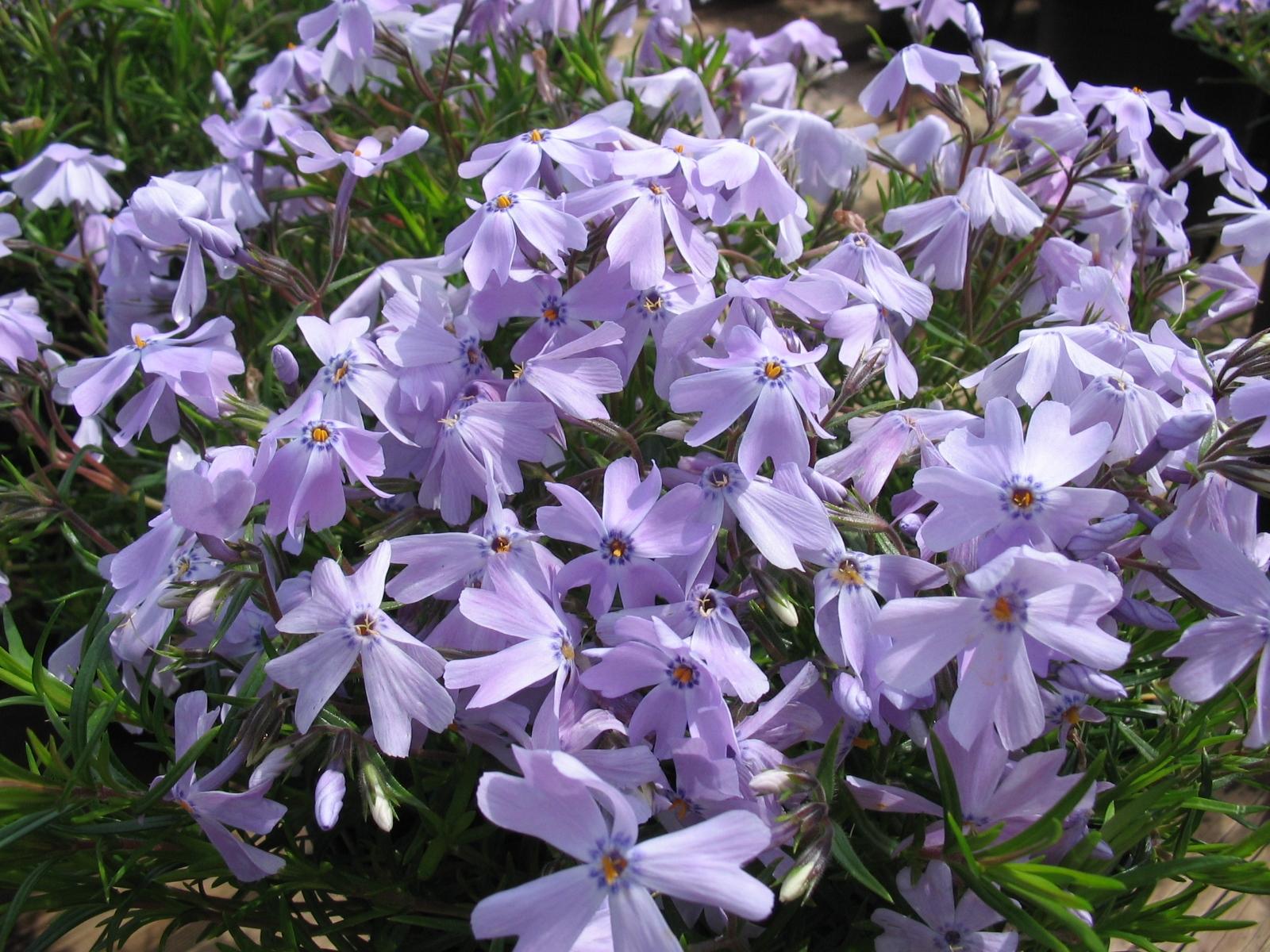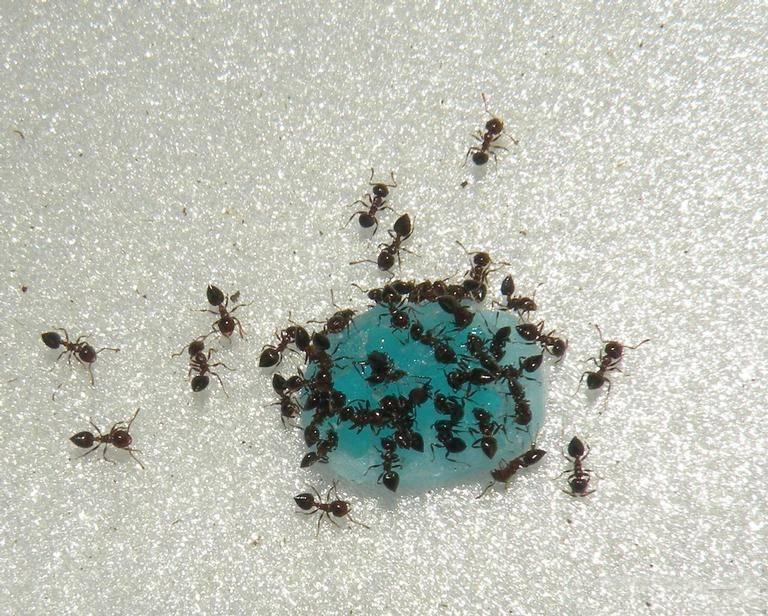
Moss phlox (Phlox subulata) is a spring-flowering, native perennial plant. Photo: Miri Talabac, UME
Sustainable Gardening
- It's National Garden Month! It's a great time of year to start a garden or incorporate new plantings. Consider adding more native plant species and plant diversity to support a more sustainable, resilient environment. Not all plants are created equal. Use science-based plant lists to know what plant species best support your local wildlife. Buy plants from local sellers if you can.
- Don't be too quick to do spring "clean-up" in the garden. Fallen leaves provide overwintering habitats for pollinators. Old leaves will decompose and add valuable nutrients to your soil.
- If you are purchasing a new mower or other gardening tools, choose manual or electric equipment instead of gasoline-powered. This will cut down on emissions that contribute to climate change.
- April showers! Capture the rain for your garden. Direct downspouts and gutters to drain water into a lawn or rain garden where it will soak into the soil rather than run off onto walkways and roads. Direct water at least 10 feet away from the house to avoid a wet basement and foundation problems.
Trees & Shrubs
- Planting or transplanting trees and shrubs can be done now and until the end of June.
- DON'T prune spring-blooming species like azalea, forsythia, and lilac until after they finish flowering.
- Symptoms of winter injury, boxwood leafminer, and Volutella blight are common problems of boxwoods that may be observed at this time of year.
Edible plants
- Put warm-season crops like tomatoes and eggplant outside after the danger of late frosts. Cool night temperatures in April will cause the first tomato fruits to become deformed or “catfaced”. Be prepared to cover tender transplants with paper bags, blankets, or other materials like row cover if frosts are anticipated.
- “Harden-off” seedlings one week prior to transplanting to toughen the plants and ready them for outdoor conditions.
- Cut fall-planted cover crops (rye, wheat, hairy vetch, crimson clover) at ground level and cover with a black weed barrier or tarp for 2-3 weeks to kill the cover crops and prevent re-growth The residues create a mulch you can plant into (no-till gardening).
- Plant fruits when weather and soil conditions are favorable. Fruits that require little or no spraying include figs, Asian persimmon, Asian pear, blueberry, blackberry, raspberry, strawberry, and currant.
- Test your soil before planting blueberries. The desired soil pH for blueberry is 4.3-5.3. Use iron sulfate and elemental sulfur to drop the soil pH, a process that can take 6-12 months. These plants establish more quickly when a generous amount of compost is worked into the soil.
Flowers
- Plant a butterfly garden. Butterflies add beauty and help pollinate flowering plants. A variety of nectar plants for adult butterflies and host plants (food) for the caterpillars will attract them. Milkweed species is a popular nectar and host plant for the Monarch butterfly.
- Many spring bulbs, like daffodils and tulips, have fully emerged and are flowering. Remove spent flowers but leave the green bulb foliage alone until it yellows and dies back naturally.
Lawns
- Lawns growing well that were fertilized in the fall should not need additional fertilizer in the spring. The best time to fertilize cool-season turfgrass (tall fescue) is in the fall.
- Lawn mowing season begins in April. The height and frequency of mowing are important to turf quality and weed management. Cool-season grasses such as tall fescue and bluegrass should be maintained between 3 - 4 inches for most of the growing season and no more than 1/3rd of the leaf blade should be removed at each mowing.
- No-Mow April or No-Mow May programs are intended to support pollinators. There are pros and cons to avoiding mowing for a month. If pollinator habitat is your goal, we recommend devoting an area to a native plant garden.
- Red thread is a disease that may become active in lawns after cool, wet weather.
Wildlife
- Eastern box turtles and various species of snakes are coming out of hibernation and may visit your yard. Box turtles are becoming scarce through much of Maryland because of road mortality and habitat destruction. Observe it but leave it in the wild.
- More than one-quarter (28%) of North American bumble bees are at risk of extinction. Learn how you can host bees in your garden by providing the habitat and nesting places they need.
- Join a hike with the Maryland Native Plant Society or a local park to see some of Maryland's beautiful wildflowers in bloom and learn about the natural habitats in which they grow.
Insects
Beneficial insects
- Assassin bug overwintering eggs are hatching and overwintering adults are emerging. These predators feed on a wide variety of garden pests. Learn what their egg masses look like, especially wheel bug egg masses, in case you see them in your landscape. Leave these insects alone so they can help with sustainable pest control.
- Lady beetles are emerging as adults from their overwintering sites and will begin laying eggs (tiny, bright yellow-orange, spindle-shaped eggs laid upright in clusters of 5-30). Both the larvae and adults are predators feeding on a wide range of garden pests. Ensure you know what their eggs and larvae look like so you can leave them in your landscape for their sustainable pest control services.
- Flower flies (also known as hover or syrphid flies) overwinter as larvae or pupae in soil or leaf litter and will begin emerging. These larvae are predators feeding on a wide range of garden pests. Ensure you know what their larvae/maggots look like so you do not mistake them as a pest.
- Mason bee adults (also known as orchard bees) typically become active mid to late April. These native bees are important native pollinators, carrying pollen between fruit trees and other flowering plants. Mason bee adults will begin looking for nesting sites this time of year, so consider adding a mason bee nest to your outdoor space.
- Carpenter bee adults become active between April and May. Carpenter bees are important pollinators, moving pollen between many of our vegetable plants and a variety of different flowers. Carpenter bee adults will begin looking for nesting sites this time of year. Consider adding carpenter bee nesting sites by adding/leaving unwanted pieces of soft wood (e.g. cedar, redwood) or adding plants with hollow reeds or stems (e.g. stiff goldenrod [Solidago rigida], raspberry canes [Rubus spp.]).
Pests
- Spotted lanternfly (SLF) eggs will start hatching in April or May, depending on the weather. Report any SLF egg hatch / early nymph sightings to the Maryland Department of Agriculture. If SLF eggs or nymphs are found in high numbers, the recommended control approach is to physically kill any spotted lanternflies that are reachable safely (mechanical controls). Found egg masses can be scraped off into a container of rubbing alcohol or hand sanitizer, or crushed. SLF is not harming landscape or garden plants enough to justify the risks of using insecticidal sprays that could harm beneficial insects.
- Aphids may begin showing up on certain plants, particularly on areas of new growth. Allow local predators like lady beetle larvae and parasitic wasps to control these early, smaller populations of aphids. For signs of parasitic wasps, look for aphid "mummies" (bloated, round and tan colored aphids). To attract and support parasitic wasps, ensure you have floral resources in the area. Most adult parasitic wasps need sources of nectar to support their nutrition.
- Eastern tent caterpillars will begin to hatch and form tents in tree “crotches”, where tree branches fork. Luckily many predators and parasitoids feed on them like birds and lady beetles. You can leave the tents for wildlife, tear them open (making it easier for predators to access the caterpillars), or prune out and dispose of the tent.
- Scale insects are typically best controlled during their vulnerable crawler stage (when their eggs hatch, the newborns are called crawlers). Some species of scale will begin hatching this time of year. Monitor for crawlers, particularly on plants with a history of scale. Specific controls and timing are based on the scale species. Utilize UMD Ask Extension for identification help.
- Viburnum leaf beetle is a serious pest of native arrowwood viburnum, cranberry bush, and many others. Look for feeding damage on viburnums and yellow larvae. Control them promptly since they can defoliate plants. Repeated defoliation can result in the death of native viburnums.
- Ticks are active when the temperature is above freezing. Wear light-colored clothing and get in the habit of checking yourself, your loved ones, and pets your pets closely for ticks after spending time outdoors. Repellents are also an effective tool to keep ticks away.
Diseases
- Cedar-apple rust disease forms its galls on Eastern redcedar (Juniperus virginiana) in April. The odd-looking galls are at first bright orange gelatinous balls with long “horns” or projections; they later turn brown and become hard. They are the alternate host structure for a disease that does very little harm to the junipers but can be quite destructive to apple trees, hawthorns, serviceberries, crabapples, and quince.
Indoor plant and insect tips
Indoor plants
- Groom indoor plants by removing dead and diseased foliage or spent flowers; this reduces insect and disease problems and improves their appearance. Gently dust the leaves with a soft rag. If possible, periodically place your plants in the shower to remove dust and to give them a good drink of water. This can revive a tired houseplant and helps to leach soluble salts (from fertilizers) from the soil.
- Fungus gnats are small, harmless black flies that hover around, breed in and feed on moist growing media. Be careful not to over-water houseplants. Growing media should be allowed to dry out before watering again.
Indoor pests
- Several species of insects are waking up from their winter dormancy inside homes. The earliest ones are multicolored Asian lady beetle, brown marmorated stink bug, cluster flies, and boxelder bugs. After emergence these insects may re-enter homes and structures during cooler days. These insects can also be found resting on sunnier sides of buildings or other structures. No chemical controls are recommended. These insects are harmless and can be swept up, released outdoors, vacuumed, or scooped into a container of soapy water.
- Different types of foraging ants may appear in your home. Try using bait stations to control minor infestations. Liquid and gel formulations are usually quite effective.

Photo: Jessica Louque, Smithers Viscient, Bugwood.org
Have a gardening question? Ask Extension!